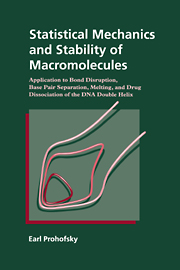 Statistical Mechanics and Stability of Macromolecules
Statistical Mechanics and Stability of Macromolecules Book contents
- Frontmatter
- Contents
- Preface
- 1 Introduction
- 2 Macromolecular stability
- 3 Lattice dynamics
- 4 Effective phonon theory
- 5 Premelting disrupted chemical bonds
- 6 Cooperative melting
- 7 Strained chemical bonds: salt and pressure effects
- 8 Bond disruption and conformation change: B to Z conformation change in DNA
- 9 Hydration effects: structural water
- 10 Helix with daunomycin intercalated: increased helix stability and daunomycin-DNA binding constant
- 11 Nonrepeating DNA
- 12 Cutting and splicing: junctions, inserts, and the replicating fork
- 13 Interaction between a helix and a single attached molecule
- 14 Energy considerations in bond opening
- Appendix 1 Helical lattice dynamics
- Appendix 2 Density matrix and effective phonon theory
- Appendix 3 Green functions
- References
- Index
5 - Premelting disrupted chemical bonds
Published online by Cambridge University Press: 16 September 2009
- Frontmatter
- Contents
- Preface
- 1 Introduction
- 2 Macromolecular stability
- 3 Lattice dynamics
- 4 Effective phonon theory
- 5 Premelting disrupted chemical bonds
- 6 Cooperative melting
- 7 Strained chemical bonds: salt and pressure effects
- 8 Bond disruption and conformation change: B to Z conformation change in DNA
- 9 Hydration effects: structural water
- 10 Helix with daunomycin intercalated: increased helix stability and daunomycin-DNA binding constant
- 11 Nonrepeating DNA
- 12 Cutting and splicing: junctions, inserts, and the replicating fork
- 13 Interaction between a helix and a single attached molecule
- 14 Energy considerations in bond opening
- Appendix 1 Helical lattice dynamics
- Appendix 2 Density matrix and effective phonon theory
- Appendix 3 Green functions
- References
- Index
Summary
Different time scales in bond dynamics
The difference in mass between electrons and atoms makes changes in atom displacements occur on a longer time scale than electronic transitions. If the atoms move, the electron orbitals adjust to the new distances on a time scale fast compared to that of the atom motion. If bonded at a particular separation where the bonded orbitals are not energetically favorable, the electrons will undergo a transition and the bond will dissociate. If not bonded at a particular separation where the orbitals are energetically favorable the bond will form. When the atom motion separates the atoms to the point where the bonded orbitals are unfavored the bond will break on a time scale fast compared to atom motion. The lasting change in bond status is on the slowest time scale and is determined by interatom distances.
The hydrogen bond involves three atoms, the hydrogen atom and the two more massive end atoms which in DNA are attached by valence bonds to the rest of the bases. This further increases their effective inertia. Because the hydrogen atom has much less mass than the end atoms there are three distinct time scales involved in H-bond dynamics.
- Type
- Chapter
- Information
- Statistical Mechanics and Stability of MacromoleculesApplication to Bond Disruption, Base Pair Separation, Melting, and Drug Dissociation of the DNA Double Helix, pp. 78 - 87Publisher: Cambridge University PressPrint publication year: 1995


